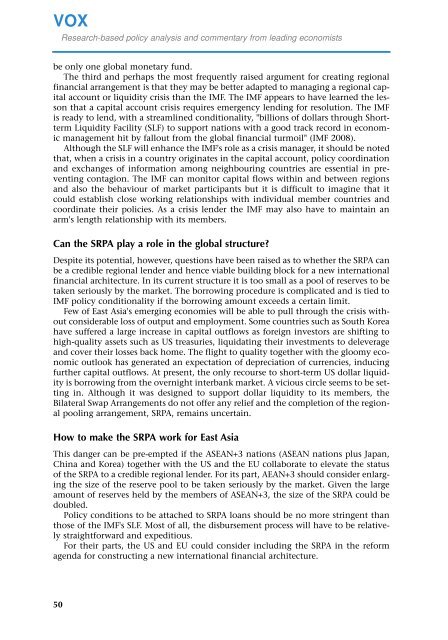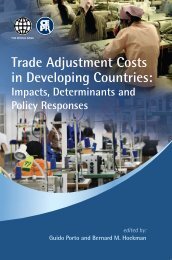What G20 Leaders Must Do To Stabilise our Economy and Fix ... - Vox
What G20 Leaders Must Do To Stabilise our Economy and Fix ... - Vox
What G20 Leaders Must Do To Stabilise our Economy and Fix ... - Vox
You also want an ePaper? Increase the reach of your titles
YUMPU automatically turns print PDFs into web optimized ePapers that Google loves.
VOXResearch-based policy analysis <strong>and</strong> commentary from leading economistsbe only one global monetary fund.The third <strong>and</strong> perhaps the most frequently raised argument for creating regionalfinancial arrangement is that they may be better adapted to managing a regional capitalaccount or liquidity crisis than the IMF. The IMF appears to have learned the lessonthat a capital account crisis requires emergency lending for resolution. The IMFis ready to lend, with a streamlined conditionality, "billions of dollars through ShorttermLiquidity Facility (SLF) to support nations with a good track record in economicmanagement hit by fallout from the global financial turmoil" (IMF 2008).Although the SLF will enhance the IMF's role as a crisis manager, it should be notedthat, when a crisis in a country originates in the capital account, policy coordination<strong>and</strong> exchanges of information among neighb<strong>our</strong>ing countries are essential in preventingcontagion. The IMF can monitor capital flows within <strong>and</strong> between regions<strong>and</strong> also the behavi<strong>our</strong> of market participants but it is difficult to imagine that itcould establish close working relationships with individual member countries <strong>and</strong>coordinate their policies. As a crisis lender the IMF may also have to maintain anarm's length relationship with its members.Can the SRPA play a role in the global structure?Despite its potential, however, questions have been raised as to whether the SRPA canbe a credible regional lender <strong>and</strong> hence viable building block for a new internationalfinancial architecture. In its current structure it is too small as a pool of reserves to betaken seriously by the market. The borrowing procedure is complicated <strong>and</strong> is tied toIMF policy conditionality if the borrowing amount exceeds a certain limit.Few of East Asia's emerging economies will be able to pull through the crisis withoutconsiderable loss of output <strong>and</strong> employment. Some countries such as South Koreahave suffered a large increase in capital outflows as foreign investors are shifting tohigh-quality assets such as US treasuries, liquidating their investments to deleverage<strong>and</strong> cover their losses back home. The flight to quality together with the gloomy economicoutlook has generated an expectation of depreciation of currencies, inducingfurther capital outflows. At present, the only rec<strong>our</strong>se to short-term US dollar liquidityis borrowing from the overnight interbank market. A vicious circle seems to be settingin. Although it was designed to support dollar liquidity to its members, theBilateral Swap Arrangements do not offer any relief <strong>and</strong> the completion of the regionalpooling arrangement, SRPA, remains uncertain.How to make the SRPA work for East AsiaThis danger can be pre-empted if the ASEAN+3 nations (ASEAN nations plus Japan,China <strong>and</strong> Korea) together with the US <strong>and</strong> the EU collaborate to elevate the statusof the SRPA to a credible regional lender. For its part, AEAN+3 should consider enlargingthe size of the reserve pool to be taken seriously by the market. Given the largeamount of reserves held by the members of ASEAN+3, the size of the SRPA could bedoubled.Policy conditions to be attached to SRPA loans should be no more stringent thanthose of the IMF's SLF. Most of all, the disbursement process will have to be relativelystraightforward <strong>and</strong> expeditious.For their parts, the US <strong>and</strong> EU could consider including the SRPA in the reformagenda for constructing a new international financial architecture.50














